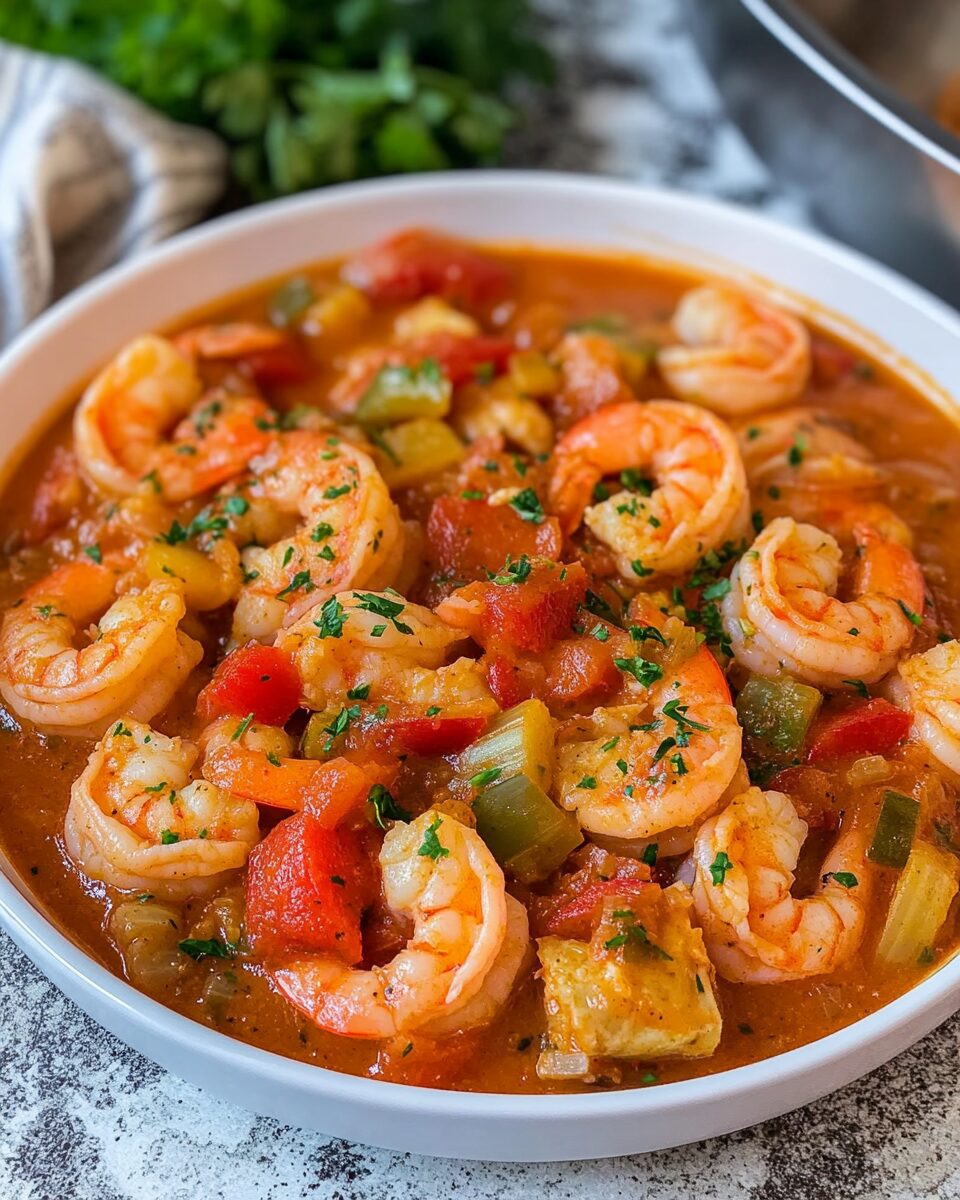The deep, rich tomato base of this Shrimp Creole delivers everything you love about southern comfort in one warming bite. With the holy trinity of onion, celery, and green pepper cooked into a slow-darkened roux, each spoonful explodes with Creole soul. Juicy shrimp simmer gently in the spiced sauce, soaking in bold flavors and ready to crown a bowl of fluffy white rice.
Shrimp Creole is not just a dish—it’s an invitation to slow down and savor. The layered aromatics and zesty sauces blend perfectly, bringing a rustic elegance to your dinner table. Whether for a weeknight indulgence or a special gathering, this Creole classic is always a showstopper.
Full recipe:
Ingredients:
-
1/4 cup all-purpose flour
-
1/2 cup canola oil
-
1 medium onion, chopped
-
1 medium green bell pepper, chopped
-
1 celery rib, chopped
-
1 garlic clove, minced
-
1 can (14.5 ounces) stewed tomatoes
-
1 can (6 ounces) tomato paste
-
4 bay leaves
-
1 tablespoon Worcestershire sauce
-
1/2 teaspoon hot pepper sauce
-
Salt and pepper to taste
-
2 pounds fresh or frozen uncooked medium shrimp, peeled and deveined
-
Hot cooked white rice, for serving
Directions:
-
In a large heavy skillet, mix the flour and canola oil until smooth.
-
Cook over medium heat, stirring constantly, until the flour is a rich deep brown (up to 20 minutes).
-
Add onion, green pepper, and celery. Sauté for 5–6 minutes until tender.
-
Stir in garlic and cook for 1 more minute.
-
Add stewed tomatoes, tomato paste, bay leaves, Worcestershire sauce, hot pepper sauce, salt, and pepper.
-
Cover and simmer for 4–5 minutes until heated through.
-
Stir in shrimp. Simmer uncovered for 5–6 minutes, until shrimp are pink and cooked through.
-
Discard bay leaves and serve hot over cooked rice.
Prep Time: 10 minutes | Cooking Time: 25 minutes | Total Time: 35 minutes
Kcal: 358 kcal | Servings: 6 servings
A Brief History of Shrimp Creole
Shrimp Creole has origins in New Orleans, a melting pot of cultures that gave birth to some of the most beloved American dishes. The Creole people, descended from French and Spanish settlers, African slaves, and native inhabitants, developed a unique cuisine that combined Old World techniques with New World ingredients. The dish draws heavily from the French practice of creating roux-based sauces and African traditions of stewing seafood and vegetables with bold seasonings.
Creole dishes often used ingredients like tomatoes, bell peppers, onions, garlic, and celery—the “holy trinity” of Creole cooking. This foundation became the base for many iconic dishes like jambalaya, étouffée, and of course, Shrimp Creole. Over time, the dish gained national popularity, becoming a Southern staple and a must-have on any New Orleans-inspired menu.
Creole vs. Cajun: What’s the Difference?
While often confused, Creole and Cajun cuisines are not the same. Cajun cooking comes from French Acadians who settled in rural Louisiana, focusing on smoky, earthy flavors and dishes that often don’t use tomatoes. On the other hand, Creole cuisine developed in urban New Orleans and includes more global ingredients like tomatoes, wine, butter, and spices like allspice and cloves.
Shrimp Creole is firmly Creole because of its heavy use of tomatoes and the complexity of its seasonings. Cajun shrimp dishes are typically spicier and may use a roux, but without tomatoes. This distinction is critical when preserving authenticity and knowing how to balance flavors properly in each dish.
Why This Dish Is a Southern Favorite
There are a few key reasons why Shrimp Creole is beloved across the South and beyond. First, it’s incredibly flavorful without being overwhelmingly spicy. While you can adjust the heat with hot pepper sauce or Creole seasoning, the core of the dish remains rich and savory, appealing to a broad range of palates.
Second, it’s a one-skillet wonder that transforms simple ingredients into something extraordinary. Shrimp Creole’s deep tomato base, enhanced by aromatics and slow-cooked roux, makes it feel hearty and soulful. It also pairs beautifully with rice, a staple in Southern cooking, which acts as the perfect vessel to soak up every drop of that luscious sauce.
Finally, it’s a dish that feels special. Whether you’re serving it to guests or treating yourself to a weeknight comfort meal, Shrimp Creole always impresses. Its gorgeous red hue and aroma make it a true centerpiece at the table.
Flavor Profile and Cooking Techniques
The flavor of Shrimp Creole is complex yet balanced. It starts with a dark roux—flour cooked in oil until it reaches a rich brown color. This technique brings a nutty depth to the base. Once the roux is ready, the “holy trinity” of vegetables—onion, bell pepper, and celery—is added and sautéed to unlock their sweetness and aromatic power.
Next, garlic, tomatoes, tomato paste, bay leaves, Worcestershire sauce, and hot pepper sauce build layers of flavor. The tomatoes bring acidity and body to the dish, while the Worcestershire offers umami depth. The bay leaves lend an herbal note that ties everything together.
Shrimp is added at the end to keep it tender and juicy. Overcooking shrimp is a common mistake, so they’re only simmered just long enough to turn pink and curl. When done right, they absorb the flavors of the sauce without becoming rubbery.
Choosing the Best Shrimp
For the best Shrimp Creole, fresh Gulf shrimp are preferred. These are widely considered among the highest-quality shrimp in the U.S. due to their natural sweetness and firm texture. However, frozen shrimp also work well if thawed properly and deveined.
The size of the shrimp can vary based on preference, but medium to large shrimp are most commonly used. If they still have shells on, peeling and deveining is essential. This can be done manually by making a shallow cut along the back and removing the dark vein with a small knife or toothpick.
Versatility and Variations
While the traditional version uses shrimp, the sauce is so flavorful that you can easily adapt the recipe to your needs. Some people add sausage, chicken, or even crawfish to the dish. Others prefer a vegetarian spin, swapping out the shrimp for hearty vegetables like okra, mushrooms, or eggplant.
The heat level is also fully customizable. You can make it mild for kids and spice it up later with hot sauce on the side. For an herbaceous twist, dried thyme, basil, oregano, and even a bit of cumin can be added for additional dimension.
Another variation is serving the Creole sauce over creamy grits or even mashed potatoes instead of rice. These versions give it a slightly different southern flair while maintaining the heart of the dish.
Storage and Make-Ahead Tips
Shrimp Creole is one of those dishes that tastes even better the next day. The sauce continues to develop depth as it rests, making leftovers a joy. Store it in an airtight container in the fridge for up to four days. Just remember to store the sauce and rice separately to maintain texture.
If you’re meal prepping or hosting guests, you can make the sauce in advance and add fresh shrimp just before serving. The sauce also freezes beautifully—just leave an inch of headspace in your container to allow for expansion.
When reheating, bring the sauce to a low simmer on the stovetop before adding the shrimp. Avoid microwaving shrimp directly as it can make them tough and dry.
Pairings and Sides
Shrimp Creole is quite filling on its own, but it pairs beautifully with a few classic southern sides. Crusty French bread or cornbread is perfect for soaking up the sauce. A simple green salad with a light vinaigrette balances the richness, while dishes like fried okra, creamy coleslaw, or corn on the cob round out the meal.
For dessert, consider keeping with the New Orleans theme—think bread pudding with whiskey sauce, beignets, or pecan pie. These add a sweet finish to a deeply satisfying meal.
Cultural Significance
This dish is more than just a recipe—it’s part of the living culture of the American South. Shrimp Creole tells a story of resilience, migration, and fusion. It’s a dish shaped by history, made in kitchens that passed down cooking methods through generations, and beloved by locals and tourists alike.
Its presence at gatherings and holidays speaks to its role as a symbol of community and comfort. In New Orleans and across the Gulf Coast, Shrimp Creole is more than food—it’s tradition on a plate.
Conclusion
Shrimp Creole is a celebration of southern flavor, cultural heritage, and culinary creativity. It brings together humble ingredients in a way that elevates them to something rich, warming, and unforgettable. From its velvety tomato sauce to its tender shrimp and aromatic foundation, every bite tells a story.
Whether you’re a seasoned southern cook or someone new to Creole cuisine, this dish is approachable and endlessly rewarding. It’s easy to make, deeply satisfying, and sure to become a regular on your dinner rotation. Most of all, it invites you to experience the vibrant flavors and heartwarming traditions of Louisiana—one bowl at a time.






